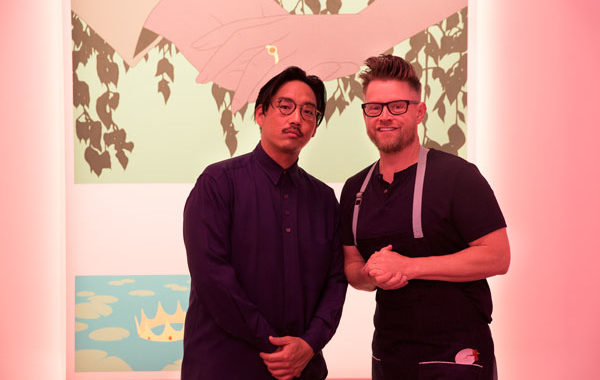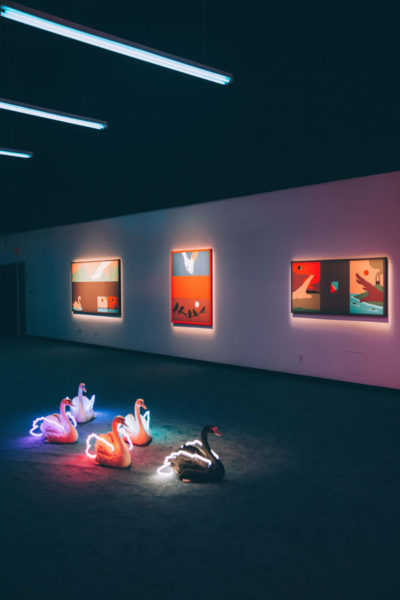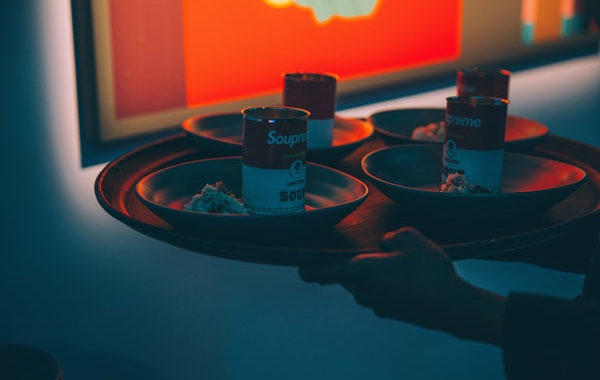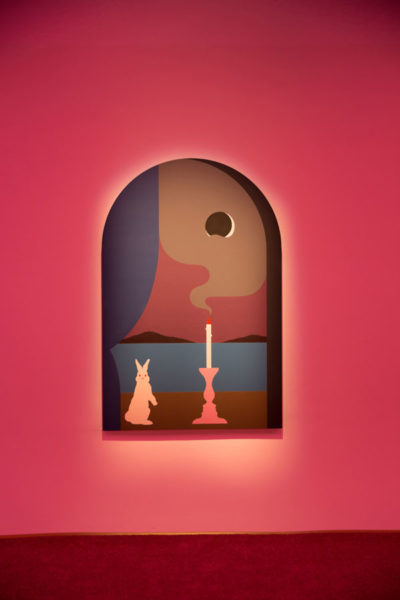When is a painting high art, and when is it just nice wallpaper?
On May 10, I learned the answer to this question when attending ARTXFOOD’s inaugural art-themed dinner, Hallowed Ground. ARTXFOOD is produced by ArtCubed Los Angeles, which hosted a “part salon, part summit happening” at Goya Studios. The event involved eating a fancy dinner designed by celebrity chef Richard Blais while surrounded by the luminous paintings and sculptures of LA-based artist Greg Ito.

Greg Ito (left) and chef Richard Blais.
Art dinners, as it so happens, are a thing—though in a weird, half-formed way. If readers do a Google search, they will discover similar centaurs in the forms of “Transparent Platform,” a production company that in 2016 held “a live art dining soirée” at London’s L’Escargot Members’ Club, inviting consumers to eat while watching artists paint a nude transgender model. And in Moss, Norway, one may nibble asparagus salad while staring at some of Edvard Munch’s metaphysical horrors at Refsnes Gods, an “art hotel” filled with Munchalia.
ARTXFOOD’s ambiance held up well to the international food-art world’s freewheeling mise-en-scène. Goya’s tasteful space was irradiated by Ito’s pop-colored show, which touched on fairy tales, family communion, and time: On the floor gleamed a big ceramic prince-frog and a parade of bright black-and-white swans. One wall featured a painting that was bifurcated into black-and-pink sections, revealing graceful hands caressing themselves amidst treetops. A triptych showed one pink hand and one brown hand reaching for the other, and two superimposed faces leaning in for a kiss.

After allowing for about 20 art-appreciation minutes, however, it was time to eat. Amiable docents led guests into an inner sanctum, the “ArtCube:” This little house held more of Ito’s art, as well as dinner tables. My favorite of Ito’s paintings presented a view through a window that revealed a striking strip of turquoise and a sparkly flame flickering among shadows… but I sort of forgot the artwork because I was eating bourbon-soaked cherries, and then came some weird-tasting Hawaiian bread doused in tepid bone marrow, and then a nice mash of chicken oysters folded in a Yuzu leaf. An insanely sweet “unicorn soup” followed, blending together sea urchin, corn and a pun. Next came black duck and onyx carrots glazed with pomegranate syrup and… charcoal dust? The latter dish excitingly recalled the noir libido-mourning feast in Joris-Karl Huysmans’ À rebours (1884); but the duck was overcooked. For dessert I despairingly licked a plate of purple ice cream, white icing, white bread and an intentional smattering of ants.

Food being served.
The goal of this hybrid spectacle appeared initially to hearken back to older, even ancient, synesthetic practices. High points in this history were reached by former painter and Provençal cuisine maître Richard Olney, and the dinners conjured by Alice B. Toklas for Gertrude Stein and friends. Though perhaps even these heroes were mere epigones of the ancient Romans: The 1st-century Pompeiian Villa of Mysteries was a safe house where elite women were trained in ecstatic Dionysian arts, and rested their orgy-exhausted limbs in a dining room (the triclinium) surrounded by ravishing frescoes of Bacchae submitting to the lash.
Dreaming of Bacchae noshing on Toklas’ pot brownies, I regret that in today’s consumerist climate a food-art event inevitably creates a fatal contest, where food will always win. Our culture has cultivated our habits of admiring and critiquing meals. But these practices are not as well supported for the arts. Does one stand before a sculpture for 30 seconds or an hour? Do we like Manet and/or Gronk? With art, there is no bitter, salty, sour or sweet—we have to access mysterious hierarchies to develop our tastes.
Thus, I would rather study Greg Ito’s work without the distractions of antsy ice cream, which nearly converted his great art into the above-mentioned wallpaper. Much depends upon dinner, and, at ARTXFOOD, its undue influence threatened to transform me into a frenzied satyr like George Costanza.

Courtesy of ArtCubed.
Some readers may recall George Costanza. He is the rotund enraged one, from Seinfeld. There’s that episode where Costanza gets in trouble with a woman because he tries to multi-platform his senses. Costanza doesn’t try to host a Pompeiian “art dinner” exactly; he wants to have sex and eat a sandwich at the same time. But when he attempts to give his lady deli-pleasure, the lunchmeat gabbles out of his mouth as if he were a zombie. His girlfriend objects by screeching and running away.
The next day, Costanza tells Jerry that he and his girlfriend broke up because he “flew too close to the sun on wings of pastrami”—as did I at ARTXFOOD, though my crashing juggernaut was made of mad aspirations weighed down by fatty bread and sugary soup.


